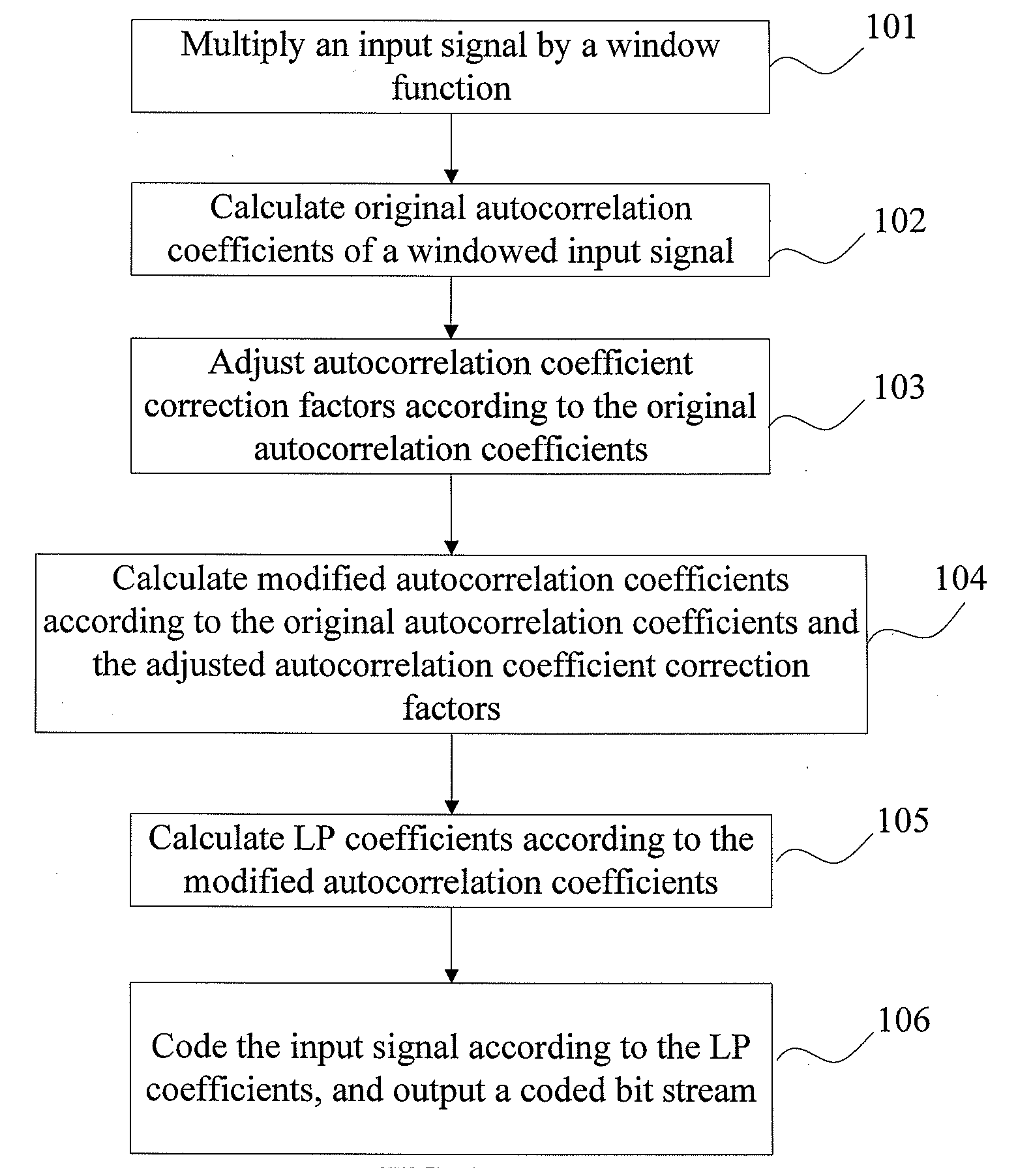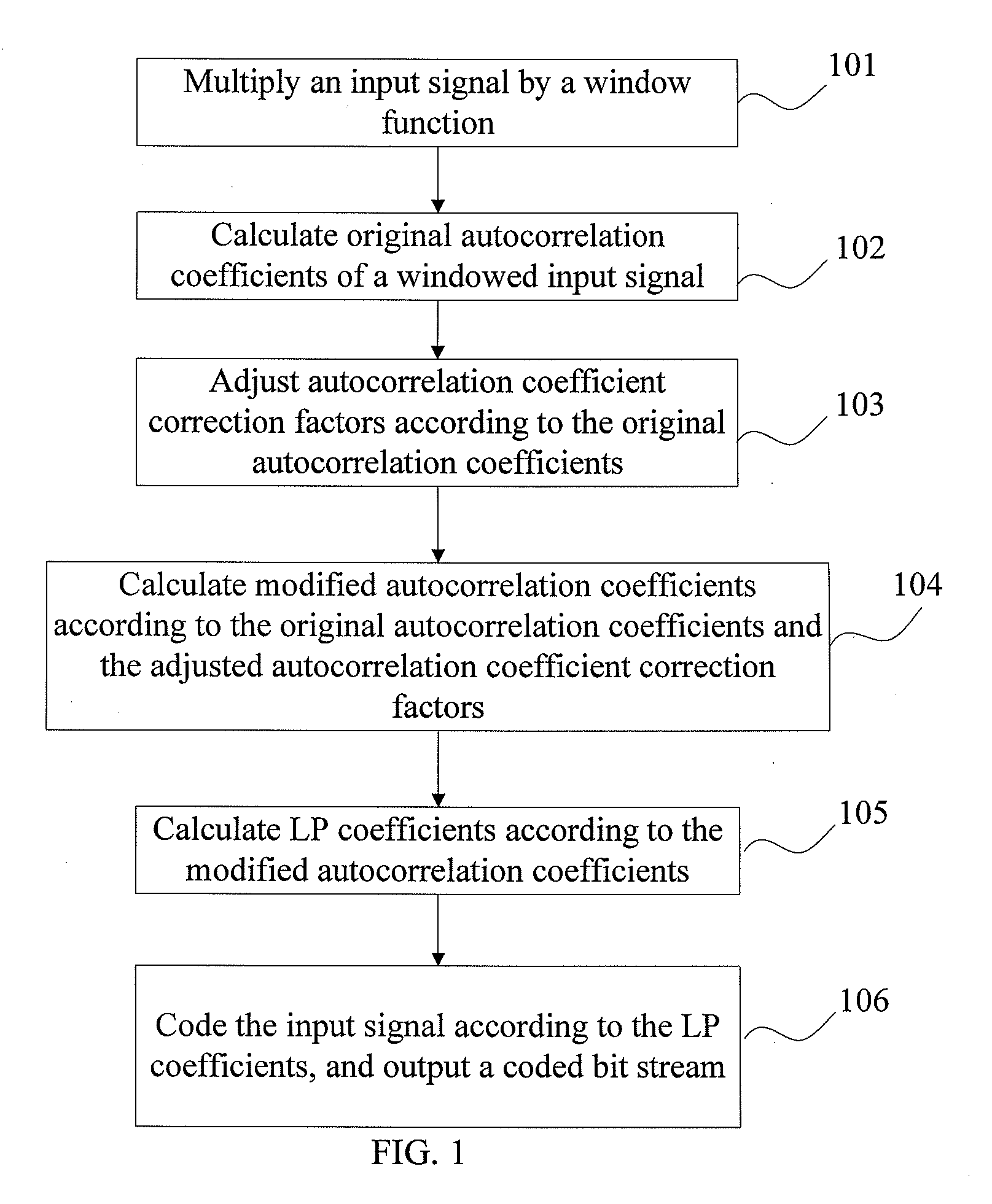Signal compression method and apparatus
a signal compression and signal technology, applied in the field of audio compression, can solve the problems of low compression efficiency of a lossless coder and low quality of reconstructed speech signals of a lossy coder, and achieve the effect of improving the compression efficiency of a lossless coder and the quality, and simple operations
- Summary
- Abstract
- Description
- Claims
- Application Information
AI Technical Summary
Benefits of technology
Problems solved by technology
Method used
Image
Examples
first embodiment
[0043]FIG. 1 is a flowchart of a signal compression method in the first embodiment of the present disclosure. The method includes the following steps:
[0044]Step 101: Multiply an input signal by a window function.
[0045]Step 102: Calculate original autocorrelation coefficients of a windowed input signal.
[0046]Step 103: Adjust autocorrelation coefficient correction factors according to the original autocorrelation coefficients.
[0047]Step 104: Calculate modified autocorrelation coefficients according to the original autocorrelation coefficients and the adjusted autocorrelation coefficient correction factors.
[0048]The autocorrelation coefficient correction factors include a white-noise correction factor and a lag-window. Adjusting the autocorrelation coefficient correction factors may be: adjusting the white-noise correction factor and the lag-window, or adjusting the white-noise correction factor only, or adjusting the lag-window only.
[0049]Adjusting the autocorrelation coefficient corr...
second embodiment
[0055]FIG. 2 is a flowchart of a signal compression method in the second embodiment of the present disclosure. The method includes the following steps:
[0056]Step 201: Multiply an input signal by a window function. The window here may be the window applied to lossy coding in the prior art. The input signal s(n) is multiplied by the window function win(n) to obtain a windowed input signal s′(n):
s′(n)=win(n)s(n) n=0, . . . N−1, where N is the frame length.
[0057]Step 202: Calculate original autocorrelation coefficients r(k) ac cording to the windowed input signal s′ (n), for example, through the following formula:
r(k)=∑n=kN-1s′(n)s′(n-k)
k=0, . . . p, where p is the order of LP.
[0058]Step 203: Calculate an energy parameter E according to the original autocorrelation coefficients.
[0059]In some embodiments, the frame average energy may be calculated according to the first coefficient r(0) of the original autocorrelation coefficients:
Ener_avg=r(0) / N, where N is the frame length.
[0060]In oth...
third embodiment
[0074]FIG. 3 is a flowchart of a signal compression method in the third embodiment of the present disclosure. The method includes the following steps:
[0075]Step 301: Multiply an input signal by a window function. The window here may be the window applied to lossy coding in the prior art. The input signal s(n) is multiplied by the window function win(n) to obtain a windowed input signal s′(n):
s′(n)=win(n)s(n) n=0, . . . N−1, where N is the frame length.
[0076]Step 302: Calculate the original autocorrelation coefficients r(k) according to the windowed input signal s′(n), for example, through the following formula:
r(k)=∑n=kN-1s′(n)s′(n-k)k=0,…,p,
[0077]where p is the order of LP.
[0078]Step 303: Determine a white-noise correction factor to be winlag(0)=1.0001.
[0079]Step 304: Calculate at least one reflection coefficient of the windowed input signal according to the original autocorrelation coefficients. In this embodiment, only the first reflection coefficient is calculated to simplify th...
PUM
 Login to View More
Login to View More Abstract
Description
Claims
Application Information
 Login to View More
Login to View More - R&D
- Intellectual Property
- Life Sciences
- Materials
- Tech Scout
- Unparalleled Data Quality
- Higher Quality Content
- 60% Fewer Hallucinations
Browse by: Latest US Patents, China's latest patents, Technical Efficacy Thesaurus, Application Domain, Technology Topic, Popular Technical Reports.
© 2025 PatSnap. All rights reserved.Legal|Privacy policy|Modern Slavery Act Transparency Statement|Sitemap|About US| Contact US: help@patsnap.com



